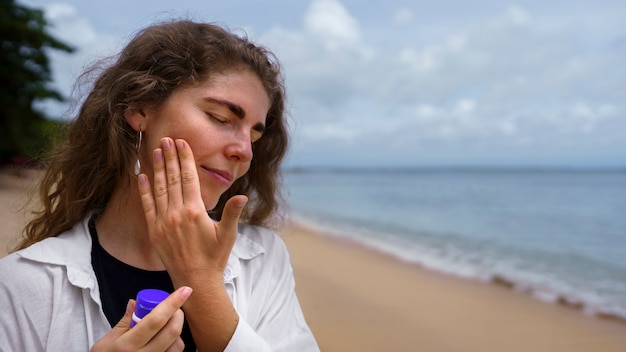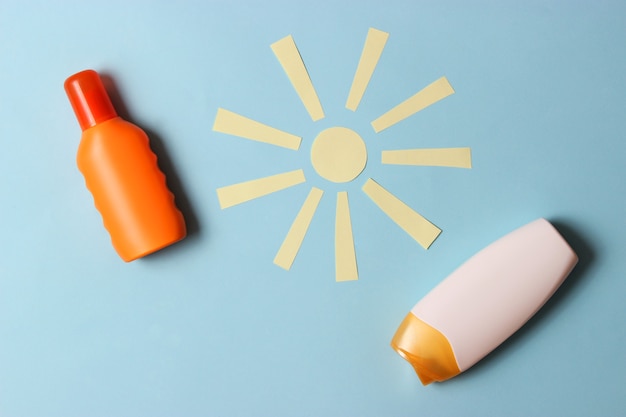Protecting Your Skin: Sunscreen Guide for 2025

Protecting your skin from sun damage in 2025 requires understanding evolving sunscreen technologies, proper application techniques, and awareness of environmental factors to minimize UV exposure and maintain healthy skin.
As we approach 2025, protecting your skin from sun damage remains a crucial aspect of overall health. This ultimate guide will delve into the most effective strategies and sunscreen technologies to keep your skin safe. Understanding the nuances of protecting your skin from sun damage: the ultimate guide to sunscreen in 2025 is essential for maintaining healthy, youthful skin.
Understanding the Risks of Sun Damage
The sun, while vital for life, emits harmful ultraviolet (UV) radiation that can significantly damage your skin. Understanding these risks is the first step in effective sun protection. This section breaks down the different types of UV rays and their potential impact.
Types of UV Radiation
UV radiation is categorized into UVA, UVB, and UVC rays. Each type has different characteristics and effects on the skin.
UVA rays penetrate deep into the skin and are responsible for premature aging and wrinkles.
UVB rays primarily affect the outer layer of the skin, causing sunburn and increasing the risk of skin cancer.
UVC rays are the most dangerous but are mostly absorbed by the ozone layer, so they pose less of a threat.
Long-Term Effects of Sun Exposure
Chronic sun exposure can lead to several long-term skin issues. It’s critical to be aware of these to prioritize sun protection.
- Increased risk of skin cancer (melanoma, basal cell carcinoma, squamous cell carcinoma)
- Premature aging (wrinkles, age spots, sagging skin)
- Sunburn and blisters
- Weakened immune system
Protecting your skin isn’t just about avoiding sunburn; it’s about preventing long-term damage that can affect your health and appearance.
In summary, recognizing the types of UV radiation and their long-term effects is crucial for adopting effective sun protection strategies. By understanding these risks, you can make informed decisions about sunscreen use and other protective measures.
Choosing the Right Sunscreen in 2025
Selecting the right sunscreen can seem overwhelming with so many products available. This section will guide you through the key factors to consider when choosing a sunscreen product in 2025.
SPF and Broad-Spectrum Protection
SPF (Sun Protection Factor) measures how well a sunscreen protects against UVB rays. Broad-spectrum protection indicates that the sunscreen guards against both UVA and UVB rays.
Mineral vs. Chemical Sunscreens
Sunscreen formulations fall into two main categories: mineral and chemical.
Mineral sunscreens use zinc oxide and titanium dioxide to create a physical barrier against UV rays.
Chemical sunscreens use chemical filters that absorb UV radiation before it can damage the skin.
- Mineral sunscreens: Gentle on sensitive skin, environmentally friendly.
- Chemical sunscreens: Lightweight, may cause irritation for some individuals.
- Consider: Your skin type, environmental concerns, and desired texture.
Choosing between mineral and chemical sunscreens depends on your personal preferences and skin sensitivity. Mineral options are often preferred for sensitive skin and environmental reasons, while chemical sunscreens offer a lighter feel.

In conclusion, selecting the right sunscreen involves understanding SPF, broad-spectrum protection, and the differences between mineral and chemical formulations. By considering these factors, you can choose a sunscreen that effectively protects your skin while aligning with your preferences and needs.
Proper Sunscreen Application Techniques
Even the best sunscreen is ineffective if not applied correctly. This section details essential application techniques to ensure optimal protection. Following these guidelines will maximize the benefits of your sunscreen.
How Much Sunscreen to Use
Applying the correct amount of sunscreen is critical. Most people don’t use enough, which significantly reduces its effectiveness.
A general guideline is to use about one ounce (30ml) of sunscreen to cover the entire body.
For the face, use about a teaspoon-sized amount.
When and How to Apply
Timing and method of application are crucial for adequate sun protection.
- Apply: 15-30 minutes before sun exposure to allow the sunscreen to bind to your skin.
- Reapply: Every two hours, or immediately after swimming or sweating.
- Ensure: Even coverage, paying attention to often-missed areas like ears, neck, and tops of feet.
Consistent and thorough application ensures that your skin remains protected throughout the day. Don’t forget to reapply, especially after activities that can remove the sunscreen layer.
In summary, proper sunscreen application involves using the right amount, applying it at the right time, and ensuring even coverage. By following these techniques, you can maximize the protective benefits of your sunscreen.
Beyond Sunscreen: Additional Protective Measures
While sunscreen is essential, it’s not the only way to protect your skin from the sun. This section explores other effective methods for reducing UV exposure.
Protective Clothing and Gear
Wearing the right clothing can significantly reduce your skin’s exposure to UV rays.
Choose tightly woven fabrics that block more sunlight.
Wear wide-brimmed hats to protect your face, neck, and ears.
Sunglasses with UV protection are essential to shield your eyes from sun damage.
Seeking Shade and Timing Outdoor Activities
Limiting your time in direct sunlight, especially during peak hours, can minimize UV exposure.
Seek shade during the sun’s most intense hours (usually between 10 am and 4 pm).
Plan outdoor activities for early morning or late afternoon when the sun is less intense.

Combining sunscreen with protective clothing, seeking shade, and planning activities around peak sun hours offers comprehensive sun protection.
In conclusion, effective sun protection extends beyond sunscreen. By incorporating protective clothing, seeking shade, and timing outdoor activities strategically, you can significantly reduce your risk of sun damage.
Sunscreen Ingredients to Watch Out For
Not all sunscreen ingredients are created equal. Some chemicals found in sunscreens have raised concerns regarding their potential impact on health and the environment. Being informed about these ingredients is crucial for making safe choices.
Controversial Chemicals
Certain chemicals commonly used in sunscreens have been the subject of debate and research.
- Oxybenzone: Linked to hormone disruption and coral reef damage.
- Octinoxate: Known to harm aquatic life and potentially disrupt endocrine function.
- Homosalate: May interfere with hormones and cause skin irritation.
Safe Alternatives
Opting for sunscreens that use safer, more environmentally friendly ingredients can provide peace of mind.
Look for mineral sunscreens with zinc oxide and titanium dioxide, which are considered safe and effective.
Choose products that are labeled “reef-safe” or “reef-friendly” to minimize harm to marine ecosystems.
Selecting sunscreens with safe, well-researched ingredients is vital for protecting not only your skin but also the environment.
In summary, being aware of potentially harmful chemicals in sunscreens and opting for safer alternatives like mineral-based products is a responsible approach to sun protection.
Future Trends in Sunscreen Technology
The field of sunscreen technology is continually evolving with innovative solutions aimed at providing better protection and user experience. This section explores some emerging trends and what to expect in the future of sunscreens.
Nanotechnology and Enhanced Formulas
Advancements in nanotechnology are leading to sunscreens with improved texture and effectiveness.
Nanoparticles can enhance the spreadability of sunscreens, providing more even coverage.
New formulations are being developed to offer higher SPF levels without compromising skin health.
Eco-Friendly and Biodegradable Options
With increasing environmental awareness, there’s a growing demand for eco-friendly sunscreens.
Researchers are developing biodegradable sunscreen formulas that minimize impact on marine life.
Sustainable packaging options, such as recycled materials, are becoming more prevalent.
Future sunscreens are likely to be more effective, user-friendly, and environmentally responsible. These innovations aim to provide better protection while minimizing harm to the planet.
In conclusion, the future of sunscreen technology looks promising with advancements in nanotechnology and a focus on eco-friendly options. These trends are set to revolutionize how we protect our skin from the sun.
Sunscreen for Different Skin Types and Conditions
Different skin types and conditions require tailored approaches to sun protection. Understanding these needs is crucial for choosing the right sunscreen.
Sensitive Skin
People with sensitive skin need gentle sunscreen formulations that minimize irritation.
- Choose: Mineral sunscreens with zinc oxide or titanium dioxide.
- Avoid: Products with fragrances, dyes, and preservatives.
- Test: New sunscreens on a small area of skin before applying to the entire body.
For individuals with sensitive skin, selecting gentle sunscreens free from harsh chemicals is essential.
Acne-Prone Skin
Sunscreen can sometimes exacerbate acne, so it’s important to choose non-comedogenic options.
Select lightweight, oil-free formulas that won’t clog pores.
Look for sunscreens that contain ingredients like niacinamide or salicylic acid to help control acne.
Choosing the right sunscreen for your skin type is critical for ensuring effective protection without causing unwanted side effects.
In summary, understanding the specific needs of different skin types and conditions is vital for choosing the most appropriate and effective sunscreen.
| Key Point | Brief Description |
|---|---|
| ☀️ SPF and Broad Spectrum | Choose sunscreens with high SPF (30+) and broad-spectrum protection against UVA/UVB. |
| 🧴 Application | Apply generously 15-30 minutes before sun exposure, reapply every two hours. |
| 🌿 Mineral vs. Chemical | Mineral sunscreens (zinc oxide, titanium dioxide) are gentler, while chemical ones are lighter. |
| 😎 Additional Protection | Wear protective clothing, seek shade, and avoid peak sun hours. |
FAQ
▼
UVA rays penetrate deep into the skin, causing aging and wrinkles. UVB rays affect the outer layer, leading to sunburn and increasing skin cancer risk.
▼
Reapply sunscreen every two hours, or immediately after swimming or sweating. Consistent reapplication ensures continuous protection throughout the day.
▼
Mineral sunscreens, with zinc oxide and titanium dioxide, are gentler on sensitive skin and environmentally friendly. Chemical sunscreens are lightweight but may cause irritation.
▼
No, expired sunscreen may not be effective because the active ingredients degrade over time. Always check the expiration date and use fresh sunscreen for optimal protection.
▼
Yes, you still need sunscreen on cloudy days because UV rays can penetrate clouds. Protecting your skin daily, regardless of weather, is essential for long-term health.
Conclusion
Protecting your skin from sun damage in 2025 involves a comprehensive approach, including choosing the right sunscreen, applying it correctly, and adopting additional protective measures. Staying informed about emerging trends and tailoring your approach to your skin type ensures optimal protection. By prioritizing these strategies, you can maintain healthy, youthful skin for years to come.
